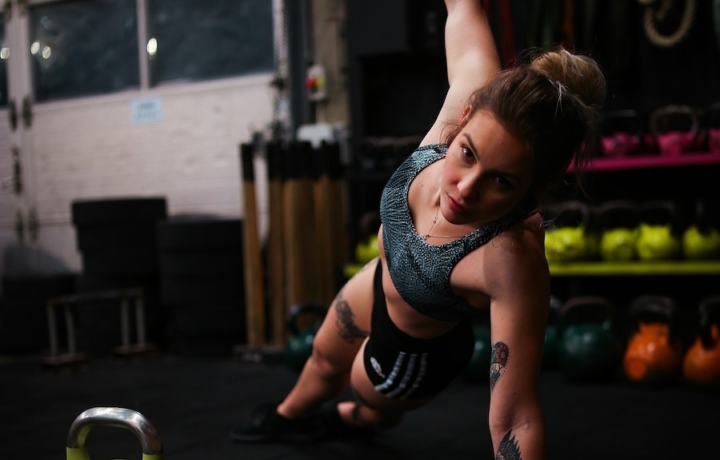Exercise
Kettlebell Russian Twist

Kettlebell Russian Twist
How to Perform
- Sit on the floor with your knees bent and feet flat, holding a kettlebell with both hands at chest level.
- Engage your core and lean back slightly until you feel your abdominals activate, lifting your feet a few inches off the ground if you're able to maintain proper form.
- Keep your spine in a neutral position with chest up and shoulders pulled back and down, away from your ears.
- Exhale as you rotate your torso to the right, bringing the kettlebell alongside your hip while keeping your arms slightly bent.
- Maintain tension in your core throughout the movement, avoiding any collapsing in your lower back.
- Inhale as you rotate back to center, then continue the movement by rotating to the left side while exhaling.
- Control the kettlebell throughout the entire range of motion, using your obliques rather than momentum to power the movement.
- Keep your knees bent and feet stable throughout the exercise, using them as counterbalance as you twist from side to side.
Important information
- Start with a lighter kettlebell until you master the movement pattern and can maintain proper form throughout the entire set.
- Keep your chest up and shoulders down throughout the movement to prevent rounding of the upper back.
- If you experience any lower back pain, decrease the range of motion or keep your feet on the floor instead of elevated.
- Focus on rotating from your torso rather than just moving your arms, ensuring the movement comes from the obliques and core.

Kettlebell Russian Twist
Exercise Details
Primary Muscles
Muscle Groups
Mechanic
Risk Areas
Built for progress
Take the guesswork out of training
Create personalized AI-powered workout plans that evolve with you. Train smarter, track every rep and keep moving forward, one workout at a time.






The Kettlebell Russian Twist stands as a powerful core-strengthening movement that has earned its place in fitness regimens worldwide. This dynamic exercise primarily targets your abs and obliques, creating that coveted rotational strength and stability essential for both athletic performance and everyday movement patterns.
Originally rooted in Russian strength training methodologies, this exercise has seamlessly integrated into modern workout protocols across HIIT, CrossFit, and bodybuilding disciplines. The beauty of the Russian Twist lies in its versatility—the kettlebell adds a challenging resistance element that intensifies the core engagement beyond what body weight alone can provide.
When incorporated regularly into your fitness routine, this movement builds remarkable core endurance while simultaneously developing those hard-to-reach oblique muscles responsible for your waistline definition. The resistance provided by the kettlebell creates time-under-tension that conventional abdominal exercises often miss, making it particularly effective for intermediate fitness enthusiasts looking to progress their core training.
What makes the Kettlebell Russian Twist particularly valuable is its functional carryover to real-world activities. The rotational component mimics movements we perform daily—reaching for items in the backseat of your car, placing groceries on shelves, or swinging a golf club. This exercise doesn't just build aesthetic appeal; it constructs practical strength that translates beyond the gym walls.
For those focused on athletic development, the improved core stability gained from consistent practice can enhance performance in virtually any sport requiring rotational power. Meanwhile, physique-focused individuals appreciate how the movement sculpts the waistline while contributing to that sought-after V-taper appearance. The metabolic demand also makes it an excellent addition to fat-burning protocols when programmed with appropriate intensity and volume.
The intermediate classification comes from the coordination and existing core strength required to perform the movement with proper form and control, making it an ideal progression once you've mastered foundational core exercises.
FAQ - Kettlebell Russian Twist
The Kettlebell Russian Twist primarily targets your obliques and rectus abdominis (six-pack muscles), while also engaging your transverse abdominis for stability. Secondary muscles worked include the hip flexors, shoulders, and lower back stabilizers that help maintain proper positioning throughout the movement.
Beginners can start with feet flat on the floor and a lighter kettlebell (or even no weight), while intermediate lifters should elevate the feet and use a moderate kettlebell. Advanced practitioners can increase the weight, extend the range of motion, or add a pause at each rotation endpoint to intensify the challenge.
The three most critical errors are allowing the hips to sag (losing the pike position), shoulders rolling forward (compromising joint safety), and excessive body wobbling due to poor core bracing. Focus on maintaining a straight line from hands to hips, keeping shoulders packed away from ears, and engaging your core throughout the movement.
For optimal results, incorporate Kettlebell Russian Twists 2-3 times weekly with at least 24 hours between sessions to allow for adequate recovery. Start with 2-3 sets of 8-12 repetitions per side, and adjust based on your fitness level and core training goals.
This exercise may not be suitable for those with existing lower back problems due to the rotational forces involved. If you have back concerns, consult with a healthcare provider before attempting, and consider starting with gentler alternatives like bird-dogs or planks to build foundational core strength first.






